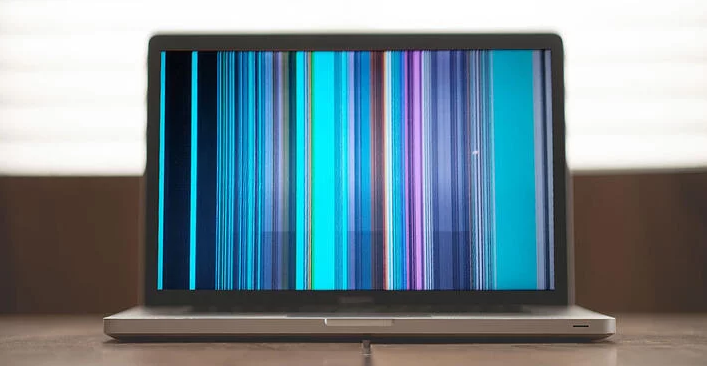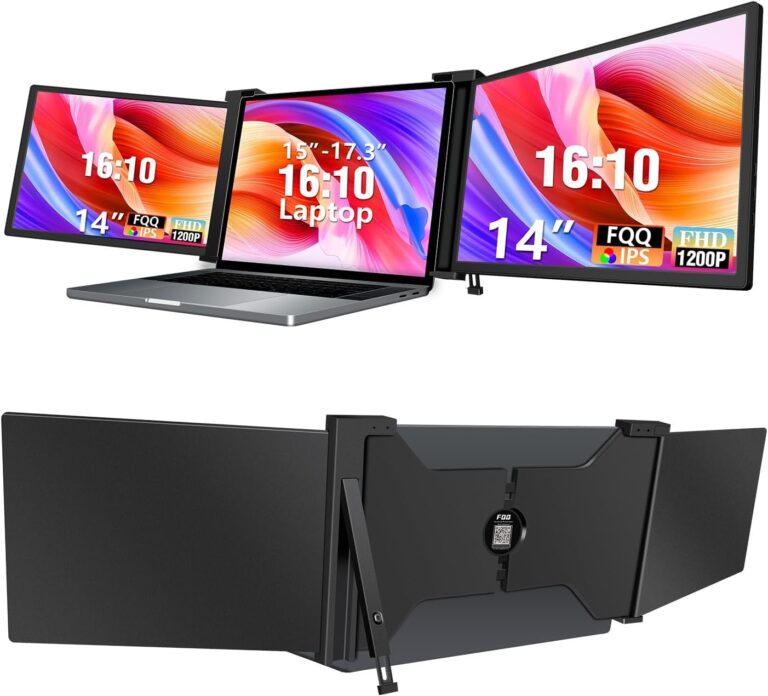Laptop monitor not working? Start by checking the connections and ensuring the screen brightness is turned up.
A non-functional laptop monitor can be frustrating. Common causes include loose connections, outdated drivers, or hardware issues. Begin by inspecting the physical connections. Make sure the laptop’s brightness settings are correct. Sometimes, a simple restart can resolve minor glitches. If the issue persists, consider updating the display drivers.
Faulty hardware like a damaged screen or malfunctioning graphics card may require professional help. Regular maintenance and prompt updates can prevent such problems. Addressing these aspects ensures smooth functioning and prolongs the laptop’s lifespan. Keep your device in top shape to avoid disruptions.
Common Causes
Is your laptop monitor not working? Let’s explore the common causes. Understanding these reasons can help you fix the problem quickly.
Hardware Issues
Hardware problems are often the main cause of a faulty laptop monitor. Here are some possible issues:
- Loose Connections: A loose cable can disrupt the display.
- Damaged Screen: Physical damage can make the screen unresponsive.
- Faulty Graphics Card: A bad graphics card affects the monitor.
- Overheating: Excessive heat can cause the screen to go blank.
Check these hardware components to ensure they are working properly.
Software Glitches
Software problems can also lead to monitor issues. Below are common software glitches:
- Driver Issues: Outdated or corrupted drivers can cause display problems.
- Operating System Bugs: Bugs in the OS can make the screen malfunction.
- Virus or Malware: Malicious software can disrupt the display functions.
- Software Conflicts: Conflicts between programs can affect the monitor.
Updating software and drivers can often resolve these issues.
By understanding these common causes, you can troubleshoot your laptop monitor effectively.

Credit: onsitego.com
Initial Checks
Facing issues with your laptop monitor not working can be frustrating. Before panicking, perform some initial checks to identify the problem. These simple steps can often resolve the issue quickly.
Power Supply
First, ensure your laptop has power. Check the power cord and adapter. Verify the power outlet is functional. You can use another device to test the outlet.
If your laptop is on battery, plug it into the charger. Look for charging indicators. Sometimes, the battery may be completely drained.
If the laptop does not show any lights, the power supply might be faulty. Try using a different charger compatible with your laptop.
Connection Ports
Next, inspect the connection ports on your laptop. Ensure there are no loose or damaged ports. Check if the external monitor is properly connected.
| Port Type | Common Issues |
|---|---|
| HDMI | Loose connections, bent pins |
| USB-C | Incompatible cables, debris in port |
| VGA | Worn-out connectors, broken pins |
Use the appropriate cable for your monitor. Ensure the cable is securely plugged into both the laptop and the monitor.
Sometimes, switching to a different port can solve the issue. Test all available ports on your laptop.
Screen Brightness
One common issue with laptop monitors is screen brightness. A dim or overly bright screen can strain your eyes and make work difficult. This blog post will help you adjust your screen brightness for better visibility and comfort.
Adjusting Settings
To adjust your screen brightness, start with your laptop’s settings. Most laptops have a dedicated section for display settings.
- Go to Settings from your start menu.
- Select System and then click on Display.
- Use the slider to adjust the brightness level.
If your laptop is too dim or bright, move the slider until it feels comfortable. Some laptops also offer automatic brightness adjustments based on ambient light.
Keyboard Shortcuts
Most laptops have keyboard shortcuts for adjusting brightness. These shortcuts usually involve the Fn key and one of the function keys (F1-F12).
| Brand | Brightness Up | Brightness Down |
|---|---|---|
| Dell | Fn + F11 | Fn + F10 |
| HP | Fn + F3 | Fn + F2 |
| Lenovo | Fn + F12 | Fn + F11 |
Remember to check your laptop’s user manual for the correct keys. Using keyboard shortcuts can save you time and make quick adjustments easier.
External Monitor
If your laptop monitor is not working, using an external monitor can be a lifesaver. An external monitor can help you continue your work without interruptions.
Connecting An External Display
First, gather the necessary cables. HDMI and VGA are common options. Make sure your laptop and monitor have compatible ports.
Follow these steps to connect:
- Turn off your laptop and the external monitor.
- Connect the cable to the laptop and the monitor.
- Turn on the monitor first, then the laptop.
Your laptop should detect the external monitor automatically. If not, press Windows + P to switch display modes.
Settings Adjustment
Adjusting settings can optimize your external monitor. Open Display Settings on your laptop.
Here’s how to do it:
- Right-click on your desktop and select Display Settings.
- Scroll down to find Multiple displays options.
- Choose between Duplicate or Extend display modes.
Duplicate mode shows the same content on both screens. Extend mode makes the external monitor an extension of your desktop.
| Mode | Description |
|---|---|
| Duplicate | Shows the same content on both screens. |
| Extend | Expands your desktop across both monitors. |
Make sure to set the resolution to match the external monitor’s native resolution for the best display quality.
Driver Updates
Driver updates are crucial for resolving laptop monitor issues. Outdated drivers can cause display problems, glitches, and even black screens. Keeping your drivers up-to-date ensures your hardware functions smoothly. This section will guide you through updating both your graphics driver and operating system.
Graphics Driver
Your graphics driver is responsible for rendering images on your screen. An outdated or corrupt graphics driver can cause your laptop monitor to malfunction.
- Check for Updates: Use your device manager to check for updates.
- Visit Manufacturer’s Website: Download the latest driver from the manufacturer’s site.
- Automatic Update: Use software like Driver Booster for automatic updates.
Steps to Update Graphics Driver:
- Open Device Manager by pressing
Windows + Xand selecting it. - Expand the “Display adapters” section.
- Right-click on your graphics card and select “Update driver.”
- Choose “Search automatically for updated driver software.”
- Follow the on-screen instructions to complete the update.
Operating System
Your operating system often includes important updates for your display drivers. Keeping your OS updated ensures compatibility and performance.
- Windows Update: Use the Windows Update tool to check for updates.
- MacOS Update: Use the App Store to find and install updates.
- Linux Update: Use your package manager to update your system.
Steps to Update Operating System:
- Open Settings by pressing
Windows + I. - Navigate to “Update & Security.”
- Click on “Check for updates.”
- Download and install any available updates.
- Restart your laptop to apply the updates.
By keeping your graphics driver and operating system updated, you can avoid many common laptop monitor issues. Regular updates ensure your system is secure and functional.
Safe Mode
Experiencing a laptop monitor not working can be frustrating. One solution is to use Safe Mode. Safe Mode helps troubleshoot issues by loading only essential drivers and services.
Booting In Safe Mode
To enter Safe Mode, follow these steps:
- Shut down your laptop.
- Press the power button to turn it on.
- Immediately press the F8 key repeatedly.
- Use the arrow keys to select Safe Mode.
- Press Enter to boot in Safe Mode.
Troubleshooting Steps
Once in Safe Mode, follow these steps to troubleshoot:
- Check Display Settings: Right-click on the desktop and select Display Settings. Ensure the correct monitor is selected.
- Update Graphics Drivers: Open Device Manager. Expand the Display Adapters section. Right-click your graphics driver and select Update Driver.
- Run System File Checker: Open Command Prompt as an administrator. Type
sfc /scannowand press Enter. This will scan and repair system files.
If the above steps do not fix the issue, consider seeking professional help. Safe Mode is a powerful tool, but some problems require expert attention.
Hardware Diagnostics
Facing issues with your laptop monitor not working can be frustrating. Diagnosing hardware problems requires a systematic approach. This section delves into Hardware Diagnostics to help you troubleshoot effectively.
Built-in Tools
Your laptop comes equipped with built-in tools to diagnose hardware issues. These tools can help you identify the root cause of the problem.
- BIOS/UEFI: Access the BIOS/UEFI settings to check if the monitor is detected.
- Device Manager: Open Device Manager to see if the monitor is listed and if there are any error codes.
- Windows Display Settings: Adjust the display settings to ensure the monitor is enabled.
These tools are essential for initial diagnostics. They provide a quick way to identify possible hardware malfunctions.
External Tools
When built-in tools don’t suffice, use external tools to diagnose the issue. These tools often offer advanced features for in-depth analysis.
- External Monitor: Connect an external monitor to see if the issue persists. This helps determine if the problem is with the laptop screen or graphics card.
- Diagnostic Software: Use software like HWMonitor or AIDA64 to check hardware health.
- Multimeter: A multimeter can help check the electrical connections and power supply.
External tools provide a comprehensive look at your hardware. They help pinpoint issues that built-in tools might miss.
Using both built-in and external tools enhances your troubleshooting process. It ensures you cover all possible angles for diagnosing your laptop monitor issue.

Credit: www.hp.com
Bios Settings
When your laptop monitor stops working, checking the BIOS settings can help. The BIOS controls fundamental hardware settings. Incorrect BIOS settings can cause display issues.
Accessing Bios
To access the BIOS, restart your laptop. While it boots, press the BIOS key. The key varies by manufacturer. Common keys are F2, F10, Delete, or Esc.
Here’s a quick guide:
| Brand | BIOS Key |
|---|---|
| Dell | F2 |
| HP | F10 |
| Lenovo | F2 |
| Acer | F2 |
Press the key repeatedly as the laptop boots. This opens the BIOS menu.
Resetting To Default
Once in the BIOS, find the option to reset to default settings. This option is usually labeled as Load Default Settings or Load Optimized Defaults.
Here’s a step-by-step guide:
- Use the arrow keys to navigate the BIOS menu.
- Locate the option to reset to default settings.
- Select the option and press Enter.
- Confirm the action if prompted.
- Save changes and exit the BIOS.
Resetting the BIOS can fix many display issues. It ensures hardware settings are correct.
Loose Connections
Experiencing a laptop monitor not working can be frustrating. Often, the issue can be as simple as loose connections. Ensuring all cables are secure can save you time and money. Let’s explore the common areas where loose connections might occur.
Internal Cables
Inside your laptop, various internal cables connect the monitor to the motherboard. These cables can become loose or disconnected over time. Check the display cable that runs from the laptop’s motherboard to the screen. Ensure it is securely connected. Loose internal cables can cause the screen to flicker or go black.
Another internal connection to check is the backlight cable. This cable powers the screen’s illumination. If it’s loose, your screen may appear dark or not light up at all. Ensure both ends of this cable are firmly attached.
External Cables
External cables also play a crucial role in your laptop’s display. Check the power adapter cable. Ensure it is plugged in securely both to the laptop and the power outlet. Loose power cables can cause the screen to go black due to insufficient power supply.
Next, inspect any external monitor cables if you use one. HDMI, VGA, or DisplayPort cables should be tightly connected. A loose connection in any of these cables can disrupt the signal and cause the external monitor to not display properly.
| Component | Issue | Solution |
|---|---|---|
| Internal Display Cable | Screen flickers or goes black | Ensure secure connection |
| Backlight Cable | Screen appears dark | Check both ends for secure attachment |
| Power Adapter Cable | Screen goes black | Ensure it’s tightly plugged in |
| External Monitor Cable | No display on external monitor | Check HDMI, VGA, or DisplayPort connections |
- Ensure all internal cables are securely connected.
- Check the power adapter cable for a secure fit.
- Inspect HDMI, VGA, or DisplayPort cables for tight connections.
Professional Help
When your laptop monitor stops working, it’s easy to feel frustrated. Professional help might be necessary to get your device back in shape. Sometimes, problems are too complex for a quick fix at home. That’s when experts come in handy.
When To Seek Help
Knowing when to seek help is crucial. Here are some signs:
- The screen remains black after turning on.
- You see flickering or strange colors.
- There are visible cracks or physical damage.
- The display works intermittently.
- All DIY fixes have failed.
If you encounter any of these issues, it’s time to consult a professional.
Choosing A Technician
Choosing the right technician is important for a smooth repair process. Here’s a simple guide:
| Criteria | Details |
|---|---|
| Experience | Look for someone with years of experience. |
| Certifications | Check if they have proper certifications. |
| Reviews | Read customer reviews for honest feedback. |
| Cost | Compare prices to find a fair deal. |
Following this guide ensures you find a reliable technician. Remember, the right professional can save you time and money.

Credit: www.reddit.com
Frequently Asked Questions
Why Is My Laptop Monitor Not Displaying?
Your laptop monitor might not display due to loose connections, faulty cables, or outdated graphics drivers. Check connections and update drivers.
What To Do If The Laptop Screen Is Not Working?
Check the laptop power and brightness settings. Restart the laptop. Connect to an external monitor to test. Update or reinstall the display drivers. Contact professional support if the issue persists.
Why Is My Laptop Not Detecting The Monitor?
Check cable connections and ensure the monitor is powered on. Update your laptop’s graphics drivers. Adjust display settings.
Conclusion
Troubleshooting a laptop monitor issue can be frustrating, but solutions are available. Check connections, update drivers, and adjust settings. If problems persist, seek professional help. Regular maintenance can prevent future issues. Stay proactive to ensure your laptop remains functional and efficient.

Hello Good People! This is Pavel and Welcome to PC Delight!
I’m an Electronics Engineer by profession with a passion for Gaming & PC builds. When I came up with the idea for PC Delight, it was my goal to share & offer the very best PC building ideas to tech-loving people like myself.
Since my school days, I’ve been just addicted to gaming & PCs. That leads me to experiment with various ways around the very niche, resulting in great productivity. And I’m here to share those practical experiences. So that next time you start some experiment with your PC builds or struggle to cope with a certain game, I’m here with the solutions. With these philosophies, I started my journey in 2017 and just kept going.
